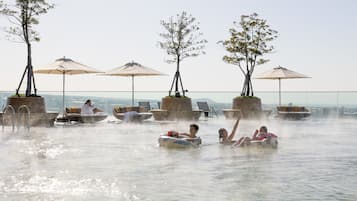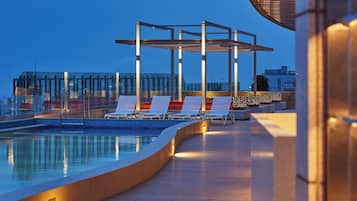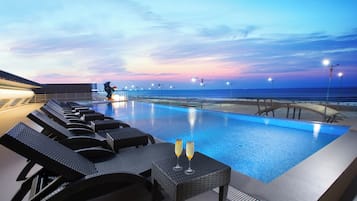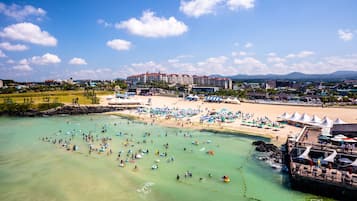Due to the volcanic topography of Jeju, the island is home to many mystical and beautiful wonders of nature. The many wonders of the island include Manjanggul Lava Tube, a tunnel created by the movement of lava, Jeongbang Falls, which offers a rare glimpse of a waterfall directly falling into the sea, and Seongsan Ilchulbong Tuff Cone, a crater where you can hike upon to view the sun rising from the sea.
Hallasan Mountain shows the many sides of mother nature, while the mystical Gotjawal was tilled by the hands of a man. The 22-metre-high Cheonjiyeon Falls is said to bring the heavens and the earth together, and the columnar joint formations, seemingly carved by giants, are wondrous sights that one can only have on Jeju. Step away from your daily grind and heal your weary heart amid the wonders of nature on Jeju.
- 1
Manjanggul Lava Tube
Massive cave created by lava

- Adventure
- Couples
- Families
- Photo
Manjanggul Lava Tube is a massive cave system reaching some 20 metres in height and more than 7 km in length. It is one of the clearest reminders of the fact that Jeju Island is a volcanic island. While lava tubes are hardly a rarity around the world, Manjanggul Lava Tube is distinguished by the fact that its internal structure has been excellently maintained, despite being formed hundreds of thousands of years ago. Coincidentally, that gives the cave system significant academic value.
In the Manjanggul Lava Tube, one can make out clear patterns of rocks and horizontal lines, showing where the lava may have flowed in the past. On the ceiling, one can find traces of bats that had once hibernated here. Unfortunately, it is difficult to see the actual bats in the cave, because visitor access is limited to just a 1 km-long stretch of the cave. The cave's temperature hovers between 11 to 21 degrees across all seasons, so make sure to pack extra layers if needed. But whatever happens, you can be assured of the likes and follows with a picture taken within this mystical cave.
Location: 182, Manjanggul-gil, Gujwa-eup, Jeju-si, Jeju-do, Republic of Korea
Open: Daily from 9 am to 6 pm, closed on the first Wednesday of every month
Phone: +82 (0)64-710-7903
Map - 2
Jeongbang Falls
Waterfall standing in harmony with coastal cliffs

- Adventure
- Couples
- Families
- Photo
The beautiful and massive Jeongbang Falls is one of the three most famous waterfalls on Jeju, alongside Cheonjeyeon and Cheonjiyeon Falls. It is the only waterfall in Korea where the water drains directly into the sea, and one of the handful to do so in the world. The water falling from the coastal cliff formation over a picturesque beach, having travelled from Hallasan Mountain through the city of Seogwipo to the sea, has a characteristic elegance reminiscent of the classical ink and brush paintings of Korea.
Go down the stairs to find the beach and the expansive sea beyond. Here, one has a fantastic view of the blue skies and the sea in perfect harmony. Walk along the rocky road, and you will eventually reach the waterfall. Up close, one can see the rainbows forming with the spray of water from the waterfall. Opening hours at Jeongbang Falls depend on the time of sunset, so make sure to leave enough time for your visit. But no matter when you visit, you are sure to find new and exciting faces of this beautiful work of nature for you to capture.
Location: 37, Chilsimni-ro 214beon-gil, Seogwipo-si, Jeju-do, Republic of Korea
Open: Daily from 9 am to 6 pm
Phone: +82 (0)64-733-1530
Map - 3
Seongsan Ilchulbong Tuff Cone
Crater with a mythically beautiful sunset

- Adventure
- Couples
- Families
- Photo
Seongsan Ilchulbong is a tuff cone with a crater resembling a massive bowl. It is one of the most recognizable places to catch the sunrise in Korea, so much so that the name is known to almost all Koreans. Originally an island, the accumulation of sand and gravel was used to build a bridge to connect to the mainland during low tide, and then eventually connected this peak to Jeju Island proper. When climbing to the top of the tuff cone, one finds a massive crater shaped like a bowl. Inside the crater lies a thriving ecosystem of plants, including silver grasses. Its Korean name, Seongsan Ilchulbong, refers to how the edges of the crater resemble a castle (Seongsan) and the beauty of the sunrise seen from the peak (Ilchulbong).
Indeed, when reaching the top of the peak, one finds a simply breathtaking view of the sea and the mist rising above the horizon. This is also the reason why an influx of visitors flock to the peak to see the sunrise. Seongsan Sunrise Festival is held here on the last day of every year. After you enjoy the festival, stick around and welcome in the new year with one of Korea's most famous sunrises.
Location: 1, Seongsan-ri, Seongsan-eup, Seogwipo-si, Jeju-do, Republic of Korea
Open: Daily from 7 am to 8 pm
Phone: +82 (0)64-783-0959
Map - 4
Hallasan National Park
Volcano with an ever-changing face across four seasons

- Adventure
- Couples
- Families
Hallasan Mountain is the southernmost mountain in Korea, and Hallasan National Park, built around the volcano, offers impressive scenery no matter the time of the year. Its biodiversity has given the volcano considerable academic value and resulted in the designation of the mountain as a UNESCO Biosphere Reserve in December 2002. About 360 oreum, parasitic cones, form a cluster around Hallasan Mountain. The scenery at Hallasan Mountain is awe-inspiring no matter the time of the year. If one had to choose, however, the colours of fall and snow-covered winter are said to be the best.
To protect the environment and to ensure the safety of all visitors, all visits to Hallasan Mountain must be reserved in advance. Reservations are available up to a month in advance. There is a daily limit of 1,000 visitors for Seongpanak Trail and 500 visitors for Gwaneumsa Trail, so make sure to secure your spot well in advance.
Location: 2070-61, 1100-ro, Jeju-si, Jeju-do, Republic of Korea
Open: Daily from 9 am to 5 pm
Phone: +82 (0)64-747-9950
Map - 5
Sojeongbang Falls
Stand under this diminutive waterfall and wish for your health

- Adventure
- Couples
- Families
- Photo
Sojeongbang Falls is located approx. 300 metres to the east of its bigger sibling, Jeongbang Falls, where the rock formations surround the waterfall like screens. A local legend on Jeju prescribes getting splashed with cold water to ensure one's health for the entire year on the day of the ghost, the fifteenth day of the seventh month in the Lunar Calendar. This makes Sojeongbang Falls a popular destination to let oneself be splashed on that day. Like its name (“little Jeongbang”), Sojeongbang Falls is smaller than its sibling, but visitors pay no heed to the size. At Sojeongbang Falls, one can see the waterfall up close along with the dainty and elegant charm of the surrounding area.
Just like Jeongbang Falls, the water at Sojeongbang drains directly into the sea. The reason behind this has to do with the formation of the waterfall, thought to be created when water started to flow over the vertical columnar joints that were created through volcanic activity. One can find sea caves in the surrounding areas, created through erosion by seawater. Sojeongbang Falls is one of the stops along Jeju Olle Trail Route 6, so make sure to stop by, catch your breath, and enjoy the view of the waterfall and the sea.
Location: 35, Chilsimni-ro 214beon-gil, Seogwipo-si, Jeju-do, Republic of Korea
Phone: +82 (0)64-733-1530
Map - 6
Cheonjiyeon Falls
Representative waterfall with beautiful scenery and flora

- Adventure
- Couples
- Families
- Photo
Cheonjiyeon Falls is certainly one of the standout waterfalls in the Seogwipo area, for both its size and scenery. The name Cheonjiyeon means “a pond between heaven and earth.” Given that it stands 22 metres tall and drains into a pond some 20 metres deep, its name is certainly appropriate
The cliff is made up of andesite, mixed with trachyte from volcanic activity, and is surrounded by a lush forest of subtropical and temperate evergreen trees and ferns. Walking trails line the area and offer great accessibility to this natural wonder. The pond is home to giant mottled eels (Anguilla marmorata), which hide during the daytime in deep waters and come out at night to feed. The highlight of Cheonjiyeon Falls is its view at night, so don't miss out on the nighttime opening of the waterfall!
Location: Cheonji-dong, Seogwipo-si, Jeju-do, Republic of Korea
Open: Daily from 9 am to 10 pm
Phone: +82 (0)64-733-1528
Map - 7
Jusangjeolli Cliffs
Grand seaside cliff surrounding the beach like a screen made out of volcanic pillars

- Adventure
- Couples
- Families
- Photo
Jusangjeolli Cliffs, consisting of columnar joint formations, are geological sites where you can see what happens when basaltic lava solidifies and erodes thereafter by the sea. The resulting formation of vertical joints resembles rectangular and hexagonal columns, seemingly carved out by giant chisels. The sight of the immaculately hexagonal pillars surrounding the area is a perfect demonstration of the mysteries of nature. What's more, tides crashing against these pillars rise up some 20 metres above sea level, creating an even more awe-inspiring view. Hard to believe? Just look at the spray of white foam breaking against the pillars.
If your visit happens to be on a windy day, a great way to take in the scenery is to see the cliffs from the sea on a boat. Walking trails and observation decks offer great places to take pictures, so make sure to bring your camera for the next great addition to your travel album.
Location: Jungmun-dong, Seogwipo-si, Jeju-do, Republic of Korea
Phone: +82 (0)64-738-1521
Map - 8
Udo Island
Island within an island

- Adventure
- Couples
- Families
- Photo
Located at the eastern tip of Jeju Island, Udo Island can be said to be an “island within an island.” The name Udo comes from its shape, which is said to resemble a prone cow. Locals also refer to the island as Soeseom or Sweseom, which also reference the island's shape. The island is gentle in slope, rich in soil and fisheries, and is home to the Eight Sights of Udo Island, making it a well-known destination for visitors. To get to the island, one can catch a ferry at Seongsan and Jongdal ports, which bring you to the island in about 15 minutes.
The island can be circled in about 3 or 4 hours of continuous walks, but most visitors opt to take buses, bicycles, or mini electric vehicles. But no matter what mode of transportation you choose, prepare to make frequent stops, since Udo Island is full of beautiful sights that include Geommeolle Beach, Udobong Peak, Rhodolith Beach, and Hagosudong Beach. Ferry operations may be subject to change depending on weather conditions, so make sure to check before you visit.
Location: Udo-myeon, Jeju-si, Jeju-do, Republic of Korea
Map - 9
Sanbangsan Canola Fields
Mountain where canola flowers bloom against the blue sky and the sea

- Couples
- Families
- Photo
The fields of canola flowers near Sanbangsan Mountain is the most popular place to see the canola flowers on Jeju. There are a number of canola fields located around Sanbangsan Mountain. Being at the southernmost point of Korea, Jeju Island is the first place to welcome spring each year, and canola flowers are the heralds of the new season. Indeed, canola flowers start to bloom in March, reach full bloom by April, and may stick around until May at the latest.
But even without the canola flowers, the scenery at Sanbangsan Mountain is sure to impress. After all, who could say no to the majestic formations of columnar joints on coastal cliffs and the beach beyond? On clear days, one has a clear view of distant islands. So time your visit right, and get ready to do some photoshoots against a memorable field of gold and the blue skies above the mountains.
Location: 142-2, Sagye-ri, Andeok-myeon, Seogwipo-si, Jeju-do, Republic of Korea
Map - 10
Hwansang Forest Gotjawal Park
Primeval forest bearing a story of a family

- Adventure
- Families
- Photo
Hwansang Forest Gotjawal Park, a “fantasy forest park,” is a jungle-like forest said to be established atop a rock. The name “Gotjawal” refers to the virgin forests of Jeju, a unique ecosystem home to staggering biodiversity atop land shaped by volcanic activity. It understandably has significant ecological value. In particular, the forest at Hwansang Forest Gotjawal Park is a mysterious place inhabited by both tropical plants near their northern limit and temperate plants at their southern limit.
Hwansang Forest Gotjawal Park was made famous by a single family, who entered the forest to flee from society after the father of the family was rendered paralysed by cerebral infarction at a young age. The family carved the paths into the forests with their own hands, and eventually opened the forest to the rest of society. Indeed, the family still resides in and manages the forest. Feel their love and passion in this beautiful and unique forest.
Location: 594-1, Nokchabunjae-ro, Hangyeong-myeon, Jeju-si, Jeju-do, Republic of Korea
Open: Monday–Saturday from 9 am to 6 pm, Sunday from 1 pm to 6 pm
Phone: +82 (0)64-772-2488
Map


















